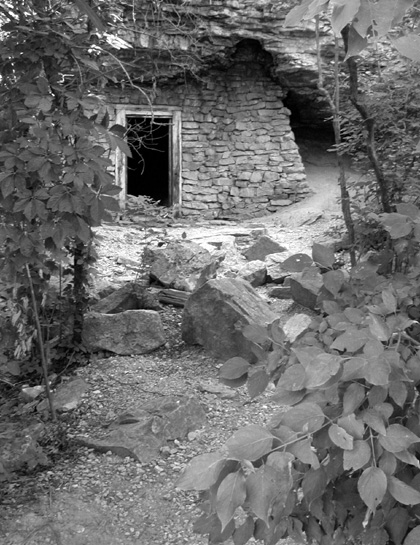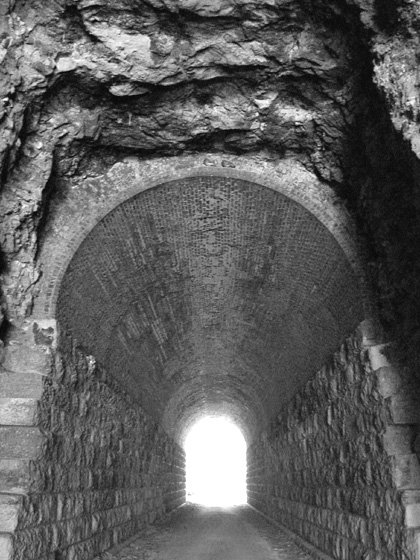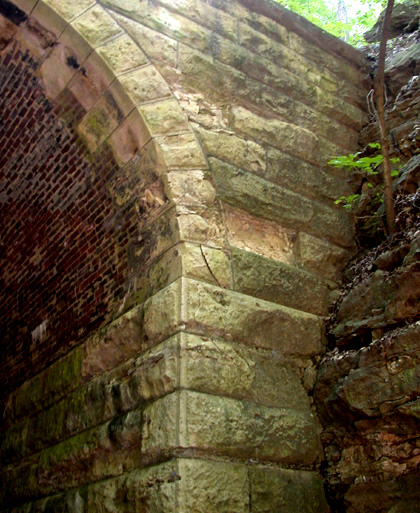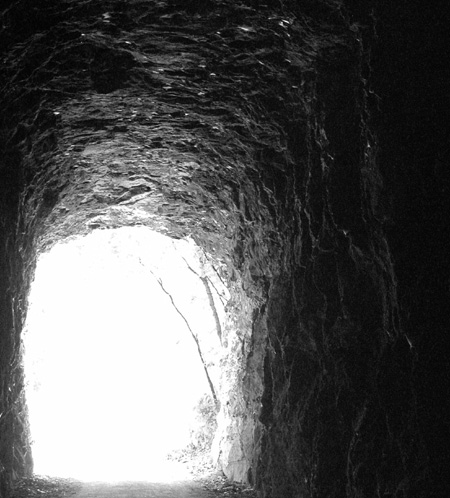The point along the Katy Trail most recommended is the area around Rocheport, and in particular, the Rocheport Tunnel. This was my goal last week when I left early in the morning to get to the town before the Missouri mid-day heat. But what started out in the heat of day, ended up in the cold, dark reaches of indian lore before this journey was over.
The Rocheport Tunnel is near the town but I wasn’t sure which way to head from the parking lot; I picked the direction to my left, which was wrong, of course. However, this stretch of the trail leads by the Missouri and past several handsome limestone cliffs, and the time spent exploring wasn’t a waste.
Katy really is a biking trail and I was the only walker among several cyclists out and about. Since the trail is long, I can see why bikes would be handy, but I think the cyclists miss the specialness of this trail by moving along at the faster speeds, view focused ahead on the loose limestone paths. The area around Rocheport is especially rich with character, and I seemed to be the only recipient of its mysteries, as I would stop and peer about at this break in the foliage, that interesting view — forming a kind of movable hazard for the bikers along the way.
Of course the Missouri river’s always fun to walk beside, and this is one of the few places along the Katy Trail where both were together rather than being separated by a strip of farmland and trees.
There was a underground stream that broke through the cliff wall at one point, behind some bushes, but you couldn’t see it unless you’re walking along; leisurely walking along at that, paying attention to your surroundings rather than burning fat on your thighs. When I stopped to check it out more closely, I found an old MKT (Missouri, Kansas, and Texas) Railway mark, sealed into the side of the hill.

In another spot I found a break in the bushes along the side of the trail and a path that led to what looked like an old abandoned stone home that had literally been built into the side of the hill underneath an overhang. Next to it was another split in the wall, and I couldn’t help thinking that the place would have to be a natural home for black bear in the winter.
In the winter, yeah, and this is summer and Missouri bears are regular teddies, but I still only went so close to both dwellings. I wouldn’t walk up to them, peer in. It wasn’t because of the bears, as much as it was that the dwellings had a odd feel to them, and there was no mention of them in any of the Katy Trail guides. Maybe there’s a reason and a risk?
Fanciful thoughts that Missouri seems to grow as plentifully as it grows the Green.

As interesting as the trail was, after a while — a hour or so — I realized I went the wrong way and turned back. I killed some time in town, getting an ice tea, chatting with some of the cyclists (finding all sorts of new trails to try, thanks to their suggestions), and finally headed towards the Tunnel.
Of course, the Tunnel is right on the Trail, at the very edge of the town only ten minutes from the parking lot. By this time of day, the weather was hot under the mid-day sun and I was looking forward to the shade of the Tunnel. Still, when I crossed the bridge over the tributary leading to the Missouri, and approached the entrance, I again experienced that same unease and reluctance to enter as I experienced earlier with the stone dwellings.

It wasn’t because I was afraid of the dark or the Tunnel — you can see the other end easily, the Tunnel is obviously solid and sound, and people are all about. Nothing to fear, but I had to push myself to enter.
(Using self-taunts of “Big Baby afraid of the dark, eh? Whimp.” to goad myself the entire time.)
I figured once I was in, I’d have no problems. I’ve been in caves and tunnels before, some a lot deeper, darker, and longer than this tunnel. However, I remained uncomfortable the entire time, and kept looking up over my head, behind me, glancing at the sides of the cave out of the corner of my eye.
Have you ever been in a place where you can feel the walls? Not that they’re closing in, as you would experience with claustrophobia; they just seem to be there, radiating their existence. I think if I had closed my eyes and held my arms out, I could have walked dead down the center of that Tunnel just by “feeling” the sides of it around me.

The interior was very dark, so I used the flash to take a couple of pictures. No hesitation on using it, what was I going to disturb? Rocks? Stone? There was nothing in the cave. Look at the photo — can you see anything in the cave but rock?
The entrance was rough rock, but the roof of the Tunnel is old hand hewn brick. Considering it’s over a hundred years old, the stability of the work is rather impressive. At the other end of the Tunnel, the entrance was cut stone — pretty in fact. I stayed outside to admire it for a while, exploring the other side of the Tunnel. Still, it was hot, and I was tired. Home it was.
Entering the Tunnel was easier going back, but if there had been any way around the Tunnel, I think I would have taken it. Self-taunts aside. Hard to figure, too, because I love tunnels.
There wasn’t anyone around returning back through the Tunnel, so I was able to hear the noise easily. Two sounds: the high pitched squeek of a bat and an owl.
The bat didn’t surprise me and I figured the flash may have disturbed it. I’m not worried about bats, and have always considered them to be rather cute, but I was surprised by the owl. There are several species of owls in the state, but it’s rare that you ever stumble on any of them unless you have a barn, or go walking around in the forest at night. No one goes out walking in the forest at night in Missouri.
The sound of the bat and the owl overcame my nervousness and I quickly entered more deeply into the tunnel, hoping to get a glance of one or the other. As I walked, I examining the ceiling overhead and the rocks at the side, trying to find a crevice big enough for a bird. Nothing,
Just as I started walking under the rough rock portion of the cave I heard a rustle and looking up, I spotted the movement of a bird among the rocks. But it was a pigeon, not an owl, or a bat. A pigeon that landed on a protruding bit of rock leading between the rough portion of the cave and the smooth, almost as if it were a guardian saying, “You’ve been this way before.” Yeah, go back.
Odd that mistake with the sound. I can usually differentiate between a pigeon and a owl, or a pigeon and a bat. Still, I couldn’t see anything else, and perhaps the echoes in the Tunnel distorted the sound enough to make it sound like an owl.

I was curious about the Tunnel and when I got home, I decided to do a little research into it’s history. And what a history that bit of land has.
It would seem that the hill that the Tunnel went through was very well known in the 1800’s, and figured prominently in Lewis and Clark’s expedition journals. At that time, the hill was called Manitou Bluff because of the huge cave drawings painted along the sides of the limestone cliffs.
From the Ozark Avalon magazine:
The term Manitou was applied to human-like figures that were included with other images — often with what appeared to be antlers emerging from their heads — in rock paintings, or pictographs, that unknown Native American artists placed on prominent projecting rocks or on the faces of bluffs.
,,,
These Manitou Bluffs, covered as they were with mysterious and undecipherable symbols and images, excited the imaginations of the American, French, and other European travelers who first encountered them. Some of these observers even speculated that the pictograph groups, especially those containing Manitous, were pictorial representations of spiritual concepts held sacred by the unknown Native American artists who inched their way along narrow rock ledges high above the ground to execute their paintings. The observers suspected that the rock paintings marked these cliffs as places particularly favored by a higher spiritual being (or Manitou) and, therefore, invested with sacred powers.
One expedition member, Sergeant John Ordway, wrote:
“We passed a high clifts of Rocks on which was painted the Pickture of the Deavel.”
We passed a high clifts of Rocks on which was painted the Pickture of the Deavel…. Picture of the Devil.
During the 1800’s the Manitou Bluffs were a common attraction among those that traveled the Missouri river during this golden age of river transportation. This was the era of Mark Twain and Huckleberry Finn, with steam boats speeding elegantly past barges and bargemen poling along the sides. Rocheport was a popular destination for these travelers, as well as a trading spot for French trappers, earlier.
Rocheport, or, translated — Rock Port. Rock Port, for the limestone cliffs and the Manitou paintings.

Of course this idyllic era ended in a burst of efficiency when the railway came through at beginning of the 1900’s. Railmen didn’t see pictographs, or spiritual symbols in the cliffs overlooking Rocheport — they saw a hill that had to be moved through, and move they did. With dynamite and rough pick, the hole was dug, and the pictures, what were considered the best of their kind, were gone.
Drawings were made of the pictographs before they were destroyed. According to the Ozark Avalon:
Future generations are lucky that Teubner made his drawings when he did, for a devastating chapter in the Manitou Bluffs saga was about to take place in the form of the Missouri-Kansas-Texas (Katy) Railroad, which began in 1892 to construct its St. Louis branch along the north side of the river. Construction crews showed no mercy for the aboriginal landmarks that had so fascinated early adventurers. As much as a hundred tons of bluff rock could be brought down with a single charge of powerful explosives. If any trace of the pictographs at Big Moniteau Creek were still visible when the railroad blasted its tunnel through the bluff at Rocheport, none has been seen since. A decade later, the Missouri Pacific built its line on the south side of the river and in the process may have destroyed all or a portion of the Little Manitou Rock. There have been no observations of the Little Manitou pictograph since Duke Paul wrote about seeing it in 1823. Not only did the railroads sound the death knell for the golden era of river transportation but they probably also literally destroyed some of the most mysterious human traces of a vanished age — the strange symbols that had excited the imagination of many river wanders who are themselves now part of a lost and romantic era.
I tried to locate the name of the people that made the drawings, but there was no identification of tribe with the descriptions of the rocks. At the time, though, the Osage land overlapped from Oklahoma into Missouri, and there’s a good chance it was Osage. This makes sense, the Osage are a very spiritual people, and they are identified with other pictographs in the area.
Coming from a town that bordered the Colville Indian Reservation, meeting other people from other tribes over time, I’ve always been fascinated and interested in Native American lore and culture. The Osage are probably one of the most fascinating of the tribes, with a rich heritage and significant history. Other tribes feared them because they were a cunning people, capable warriors, and tall — most averaging 6 feet in height, and this during a time when average heights were about 5 1/2 feet.
Though pushed about by the long knives, the white man, as with other tribes, the Osage held its own more than others. Additionally, as I said earlier, they are a very spiritual people with fascinating stories and legends surviving through the ages. Among the many Osage beliefs is that of little people. Supernatural spirits.
Of course, coming from Irish ancestry, I know the little people, and I’m sure you do also, coming from whatever people you call your own. Mine were friendly and mischievous, jokers, pranksters but with no real harm to them. However, the same cannot be said for the Osage Little People, all of whom were Osage who died without paint, and without honor. They were the mialuschka, the Lost Souls.
The Osage Little People are treated with both respect and fear because unlike friendly spirits, they are vindictive, dangerous, even deadly. They walk the earth hungry and full of hatred for their unsettled state and they would like nothing better than to add to their ranks from among those they consider their prey. This would include any who desecrate their holy lands — burial and other ceremonial lands. Lands that Osage shaman would sometimes paint with great big pictures, of Manitou and other creatures.
The Little People might be content with playing a prank, or scaring their Prey. They might spoil food, or chase a skunk into a home. But their pranks could become deadly — trees falling on a windless day, or rocks falling down from a cliff with no creatures present. If the Little People were very angry, the Prey would have to get a blessing from a Shaman, and even then, that would sometimes not be enough to turn aside their wrath.
The thing with the Little People, only an Osage Shaman can sense their presence — a Shaman or the sometimes the Prey themselves. If you were such a one you might see them as indians dressed in the native costume of the time. Hair shaved into a mohawk, blanket wrapped, face without paint. Dead eyes, burning with the light of night.
Sometimes, though, you won’t see the Little People as people, but they’re still about. They have another guise, that of a bird. An owl to be exact. And you’ll know they’re around you, when they’re looking at you, when they’ve spotted you as prey, when you hear the owl’s song.








